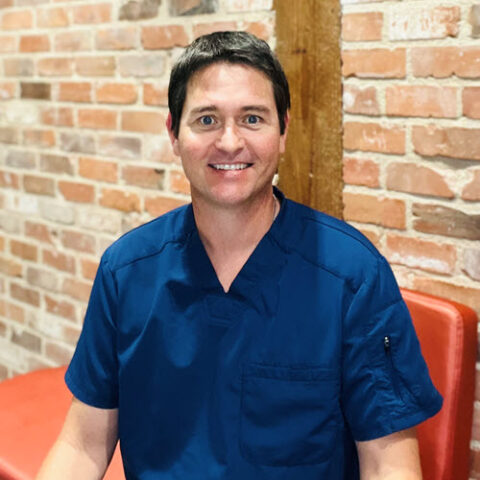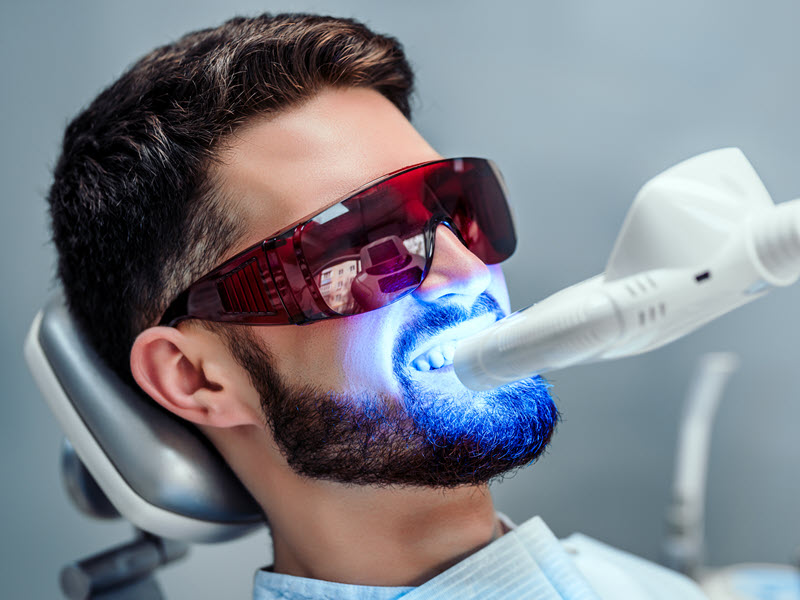Quicker, More Comfortable Dental Cleanings
At Murphy Dental, we’re always looking for new ways to be more efficient and effective with treating our patients.. One of the most exciting technology innovations we’ve invested in is Guided Biofilm Therapy. This technology allows a dental hygienist to perform a teeth cleaning more thoroughly and comfortably than relying solely on scalers. With Guided Biofilm Therapy, your dental cleaning will be more comfortable and even a bit shorter than a traditional dental cleaning.
Guided Biofilm Therapy (GBT) offers an innovative way to manage dental biofilm. It uses advanced technologies called AIRFLOW®, PERIOFLOW®, and PIEZON®.
Biofilm is a sticky layer of bacteria on your teeth. If not removed, it can lead to cavities and gum disease. GBT systematically removes biofilm using modern methods.
GBT involves several steps. First, a disclosing agent highlights the biofilm (bacteria) so it is visible to your dental hygienist. Next, an air abrasive powder removes the plaque. Finally, a specialized nozzle is used to clean subgingival biofilm that is hiding under the gums.
Guided Biofilm Therapy is not just effective; it is also more comfortable than traditional methods. You will feel fewer vibrations and hear less noise during the procedure. We understand that a visit to the dentist is stressful for many, and GBT makes the experience easier on dental patients.
The Role of Biofilm in Oral Health
Biofilm is a group of microorganisms that sticks to the surface of your teeth. It includes bacteria, fungi, and other microbes.
Dental biofilm can have both positive and negative effects on your oral health. On one hand, some bacteria help protect your teeth. On the other hand, harmful bacteria in biofilm can lead to issues like periodontal disease and caries.
Impacts of Biofilm
- Periodontal Disease
- Biofilm buildup affects your gums.
- It causes inflammation and can destroy tissue.
- Caries (cavities)
- Harmful bacteria produce acids.
- These acids demineralize tooth enamel, leading to cavities.
Connection to Systemic Health
Oral biofilm doesn’t only affect your mouth. It can influence your whole body.
- Heart Disease: Bacteria from the mouth can enter the bloodstream and potentially affect heart valves.
- Diabetes: Poor oral health can make it harder to control blood sugar levels.
Managing Biofilm
Effective management involves regular dental cleanings and good oral hygiene. Your front line of defense is good home care and coming into a dental office for preventive cleanings.
- Brushing: Twice a day to remove biofilm.
- Flossing: Daily to clean between teeth.
- Professional Cleanings: Can target hard-to-reach areas.
Principles of Guided Biofilm Therapy

Comparing GBT to Traditional Dental Cleaning Methods
Guided Biofilm Therapy (GBT) aims to manage biofilm while being minimally invasive. GBT targets plaque and calculus to prevent diseases like periodontitis and peri-implantitis. It uses air-flow technologies for precise cleaning.
Steps of GBT:
- Detection: A disclosing agent reveals plaque.
- Removal: Air abrasive powder removes plaque and stains.
- Polishing: Smooths tooth surfaces.
- Follow-up: Regular maintenance sessions.
GBT focuses on preserving healthy tissues. No need for invasive tools keeps discomfort minimal. It secures comfort and safety for patients.
Benefits of GBT:
- Effective: Removes biofilm better than traditional methods.
- Comfortable: Less pain and discomfort.
- Time-saving: Quicker than hand instruments.
Indications:
- Preventive Care: Helps in regular dental check-ups.
- Therapeutic Care: Useful for treating periodontitis and peri-implantitis (as we’ll discuss in a moment)
GBT ensures thorough biofilm removal without harming the gums or teeth. It’s suitable for both natural teeth and recommended for implants as well. You experience a gentle yet effective cleaning process.
By focusing on early detection and removal, GBT reduces the risk of dental diseases. This method supports oral health while minimizing risks.
Clinical Implementation of GBT
Guided Biofilm Therapy (GBT) uses a systematic approach involving assessment, biofilm disclosure, patient motivation, and advanced cleaning techniques. These procedures ensure precise biofilm management, enhancing dental health.
Patient Assessment and Diagnosis
First, your dentist will assess your overall dental health. You will be assessed for signs of periodontal disease and plaque buildup. You’ll also be asked about your dental hygiene routine. As part of the evaluation, a detailed risk assessment will be conducted to identify factors like smoking or poor oral hygiene that could contribute towards dental issues. Your gum health will also be assessed with periodontal probing to detect any periodontal infections.
Identify Biofilm
Use a special dye to disclose the biofilm on the patient’s teeth. This dye spots hidden biofilm, making it visible to the hygienist (who may also share what the highlighted biofilm looks like to you). This can be helpful in visibly showing you the areas they need to brush better at home.
The hygienist will then explain how biofilm leads to cavities and gum disease. They will also help educate and guide you with the steps you need to work on at home to achieve optimal oral health.
Biofilm Removal Techniques
For removing the actual biofilm, your hygienist will start with an Airflow device; this cleans without touching the teeth directly, making it more comfortable for you. The Airflow technology uses erythritol powder, an effective agent against biofilm.
While all steps to eliminate scalers are taken, there may be some ultrasonic scaling needed to remove the mineralized biofilm; this is very minimal if needed. Overall, the use of scalers is greatly reduced when compared to a traditional dental cleaning.
Subgingival Cleaning with Perioflow
Getting rid of biofilm under the gums(subgingival) is a bit trickier than biofilm that resides on the surface of the tooth. For cleaning under the gum line, your hygienist will use a Perioflow device. This tool reaches the subgingival areas where traditional tools might miss. The erythritol powder is used again – note that it is safe and gentle on gums. It also effectively removes biofilm in periodontal pockets.
Supragingival Air Polishing
For cleaning above the gum line, hygienists use supragingival air polishing techniques. This step removes the biofilm and stains from the tooth surface. The air-polishing device uses a stream of air, water, and erythritol powder to gently clean the teeth. The supragingival approach also ensures that the teeth remain smooth, which helps in preventing future biofilm accumulation.
This method is efficient and less invasive than traditional polishing. Most patients feel extremely comfortable compared to traditional teeth cleaning experiences.
Patient Comfort and Safety
Guided biofilm therapy (GBT) focuses on patient comfort and safety. This treatment is gentle and avoids causing pain.
Comfort is a top priority. During GBT, you will stay relaxed. The process is quick and efficient. The time in the dental chair will be significantly less than what you’ve experienced from past cleanings.
Safety is essential. This therapy is extremely safe and uses advanced technology to ensure a safe experience. There is minimal risk of damaging your teeth or gums. Your dental office will follow strict protocols to keep everything clean and hygienic.
GBT and Periodontal Care
Guided Biofilm Therapy (GBT) plays a crucial role in the treatment and management of periodontal and peri-implant diseases. This includes methods to handle both periodontitis and conditions affecting dental implants.
Treatment of Periodontitis
GBT is effective in treating periodontitis when combined with consistent oral hygiene practices. These tools help remove dental biofilm, early calculus, and remaining calculus from tooth surfaces. This is crucial for preventing further tissue damage.
As with dental cleanings the treatment for periodontal disease follows a step-by-step protocol. It first involves disclosing agents. These agents make the biofilm visible. Cleaning then targets these areas with precision. High-efficiency devices, such as air polishing systems, remove the deposits gently. This reduces discomfort and enhances patient experience.
Supportive Periodontal Therapy (SPT) also benefits from GBT. By regularly applying GBT, you can maintain periodontal health and avoid recurring issues. This proactive approach aligns with guidelines from the European Federation of Periodontology.
Management of Peri-Implant Diseases
Dental restorations can come with their own risks. Guided Biofilm Therapy proves valuable in managing peri-implant diseases. These are a special subset of inflammatory diseases that affect both the hard gum tissue and the soft tissue around dental implants.
These diseases include peri-implantitis and mucositis. The buildup of biofilm around gum tissues adjacent to dental implants can compromise the stability of the implants. GBT helps in cleaning around the implants effectively.
Effective biofilm removal around implants prevents inflammation. It also stops the progression to peri-implantitis. Techniques used in Guided Biofilm Therapy include the use of low-abrasive powders and special nozzles. These tools safely clean implant surfaces without causing damage.
Regular maintenance with GBT improves implant longevity. It ensures that mucositis does not advance to more severe conditions. This approach keeps implant sites healthy and functional for a longer time.















